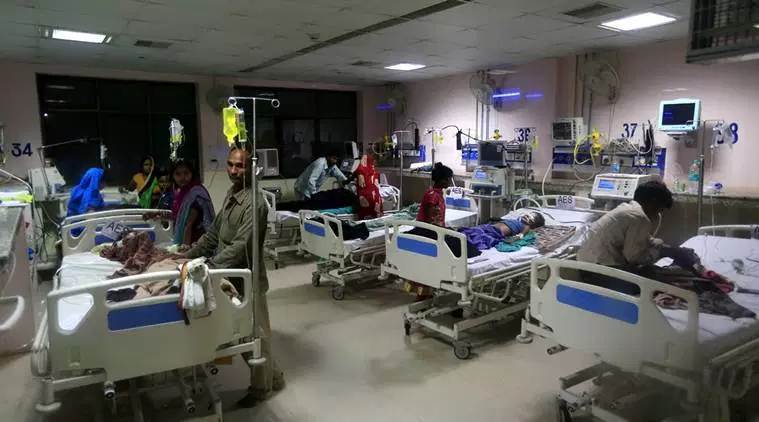The state government has not cited AES as cause of death and has instead attributed most of them to hypoglycemia — meaning low blood sugar level. Experts, however, say hypoglycemia is one aspect of AES.
As many as 43 children below the age of 10 years have died at two hospitals in Bihar’s Muzaffarpur district this month after being admitted with Acute Encephalitis Syndrome (AES).
The state government has not cited AES as cause of death and has instead attributed most of them to hypoglycemia — meaning low blood sugar level. Experts, however, say hypoglycemia is one aspect of AES.
A seven-member Central government team is likely to visit the hospitals soon and suggest guidelines.
Bihar Chief Minister Nitish Kumar has expressed concern over the situation and directed the health department to ensure that primary health care centres and hospitals follow standard operating procedures to deal with the cases.
Since this January, 172 children aged below 10 have been admitted to the two hospitals with AES. Of them, 157 have been admitted since June 1 and all 43 deaths have been reported in June.
Shri Krishna Medical College and Hospital (SKMCH) took in 117 such patients since January — 102 of these were admitted in June and 36 of them died.
Kejriwal Matrisadan admitted 55 AES cases since June 1 and of them, seven children have died. Currently, four patients in Kejriwal Matrisadan and six children in SKMCH are in a critical condition. The hospitals have discharged 41 children with AES after treatment.
AES still a challenge for Bihar govt
Ever since AES cases were first reported in Muzaffarpur and surrounding areas in 1994, it has remained a challenge for the Bihar government, despite its claims of being prepared to deal with it. Several researches have only narrowed down to heat, humidity and malnutrition as the reasons. Blame it on the lack of an awareness campaign or any programme ro deal with nutrition, AES spurt has often exposed the health department’s lack of preparedness. In 2012, 120 children died due to AES, followed by 90 such deaths in 2014.
SKMCH currently has 53 children with AES, most of them from in and around the town and hailing from poor families.
Ramesh Manjhi’s only son Gulshan Kumar (4) is one of them. “Since there is no bed, we made Gulshan sleep on the floor. Hope there are no further complications and he is discharged soon,” said Ramesh, a mason from Turki.
Raj Kishore Mahto from Paru is worried as his daughter Julie Kumari (7) has been unconscious since Tuesday. Doctors have said the admission was delayed and she would take time to respond to the treatment.
A nurse said that most children admitted with AES are suffering from hypoglycemia and some are suffering from hyperglycemia. A doctor said, “Parents should be alert when their children do not eat properly and vomit. Going to local quacks worsens the case. Almost all patients are from poor families and are malnourished.”
Nurses said they were under pressure to use “hypoglycemia” instead of AES because “it brought a bad name to the state government”.
SKMCH Medical Superintendent Dr S K Shahi told The Indian Express, “All cases come under the broad term of AES, but people consider it a disease when it is just a syndrome. Hypoglycemia is the specific reason for most deaths.”
“We are avoiding using AES because of the wrong perception it creates. Of the 36 deaths reported here, 25 occurred because of hypoglycemia and five due to hypoglycemia and electrolytes imbalance. Reasons of six deaths are not known.” He added that of the samples picked from the hospital, only two were confirmed cases of Japanese Encephalitis.
Dr Arun Shah, executive committee member of the Indian Academy of Paediatrics Association and a leading paediatrician in the district, said, “How can anyone say these are not AES cases? Hypoglycemia is just a part of it. A healthy child has a reserve of sugar, but a poor and undernourished child has no buffer stock of sugar in her body. Hot and humid weather, lack of cleanliness and malnutrition are the reasons behind AES incidence.”
“The state government failed to run a nutrition programme and awareness campaign which should have been started in February. It is very easy to hide behind the medical jargon of hypoglycemia. They should find ways to deal with hypoglycemia to tackle AES.”
Bihar health department principal secretary Sanjay Kumar said, “We hope to get some guidelines from the Central team. Most deaths occured due to hypoglycemia. Some of these patients hailed from Sitamarhi, Sheohar, Vaishali and East Champaran districts.”
Source: Read Full Article


